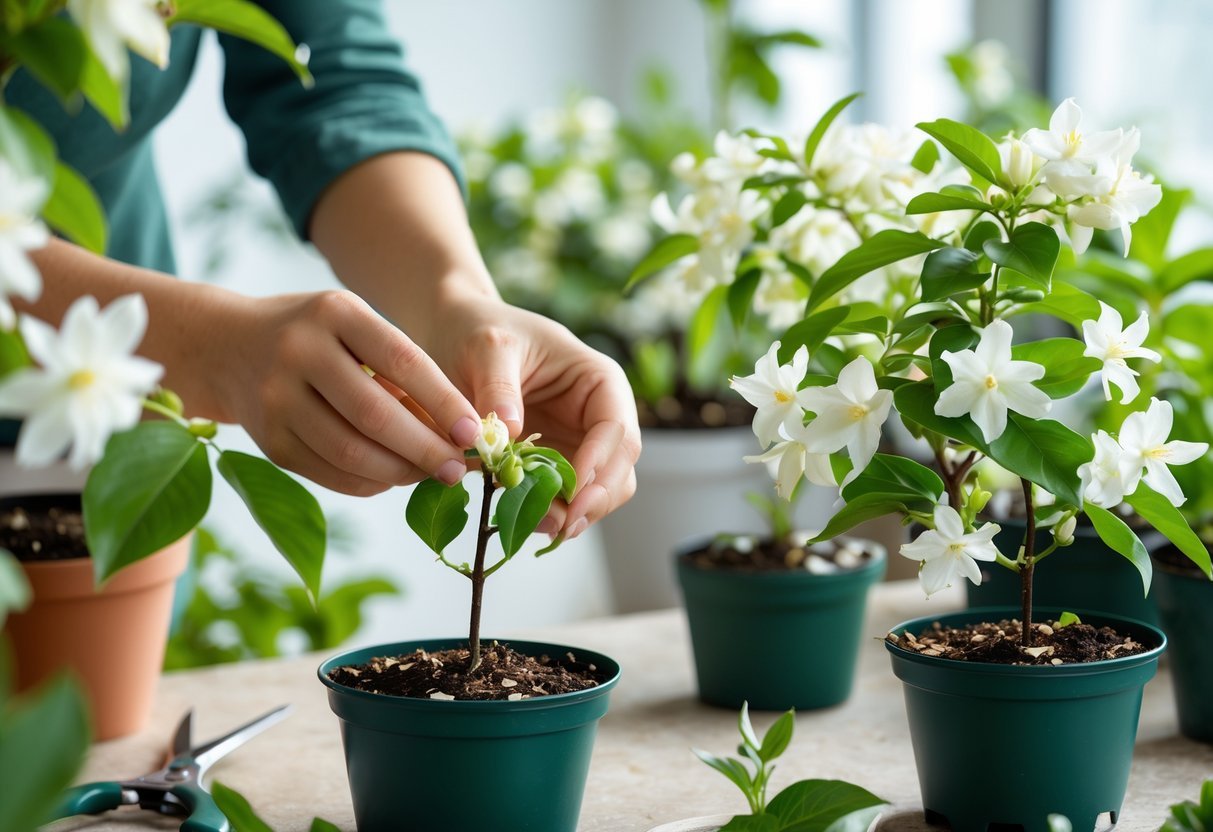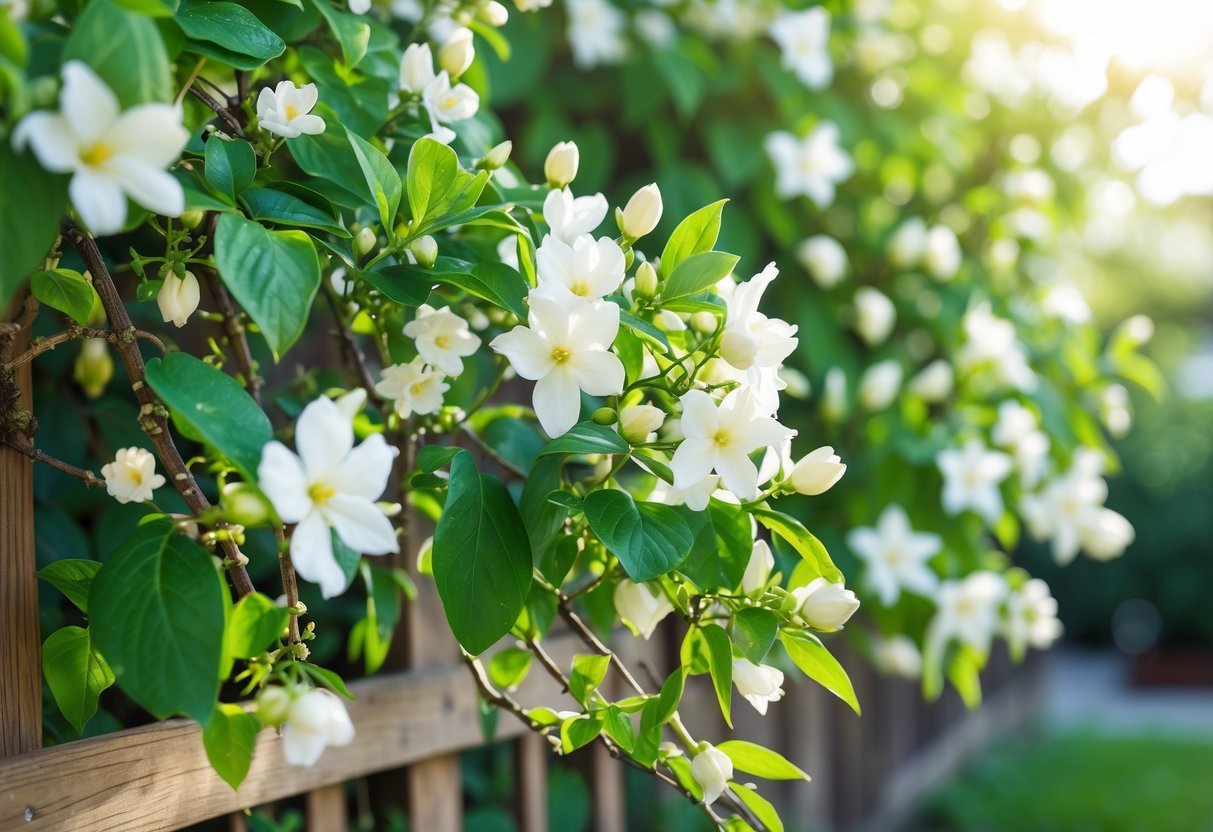Jasmine plants have this way of lighting up a space, whether you’re talking about a sunny garden or a cozy windowsill. Their star-shaped flowers and sweet, unmistakable scent are hard to beat. If you want jasmine to really thrive, pick the right variety, give it rich, loose soil that drains well, and don’t skimp on sunlight. Keeping the soil moist (not soggy!) during the growing season and giving it a little food now and again will go a long way toward those dreamy blooms.
You’ll find jasmine in all sorts of shapes—some are climbers, others are tidy little shrubs. They can be happy sprawling outdoors, tucked into a container, or even living indoors if you’ve got the right spot. If you keep up with pruning and make sure they get enough light, you’ll be rewarded with those trademark blossoms and a scent that’s honestly kind of addictive.
Understanding Jasmine Plants
Jasmine isn’t just one plant—it’s a whole cast of characters, each with its own quirks. Some are delicate, some tough as nails, and their flowers range from faintly scented to “wow, that’s strong.” If you’re thinking about growing jasmine, getting a handle on their basic traits and growth habits will help you pick the right one for your space.
Jasmine Genus and Botanical Features
Jasmine belongs to the Jasminum genus, which honestly covers a lot of ground—about 200 species. You’ll find everything from woody little shrubs to wild climbing vines, all part of the Oleaceae family (yep, that’s the same one as olives and lilacs).
Leaves can be simple or compound, and the flowers are usually small, tubular, and mostly white or yellow—sometimes pink sneaks in. These flowers are built to lure in pollinators like moths and bees.
Depending on the species and where they’re growing, you’ll see a lot of variation in leaves and stems. Some jasmines are evergreen with shiny leaves, others drop their foliage when it gets chilly. With a bit of care, most will do just fine indoors or out.
Growth Habits: Vines, Shrubs, and Evergreens
Jasmines can be rambling vines or neat shrubs. Vining types like Jasminum polyanthum will happily climb whatever you give them—trellises, fences, you name it.
Shrubby sorts, like Jasminum nudiflorum, are more compact and often easier to wrangle as standalone plants. Many of these are evergreen, so you get green leaves all year.
Where you plant them really depends on their growth style. Vines need something to climb, while shrubs can hold their own along borders or as foundation plants. Containers? They’re surprisingly adaptable.
Deciduous vs. Evergreen Jasmine
Some jasmines are evergreen, others drop their leaves when the cold hits. Deciduous types go bare in winter to save energy, then bounce back in spring.
Evergreen varieties keep their leaves and look lively all year, especially if you’re in a mild climate. If you want greenery through winter, evergreen’s your friend. If you don’t mind a little seasonal change, deciduous types mix things up.
Fragrant Flowers and Their Uses
Jasmine’s scent is pretty legendary—sweet, rich, and just a bit exotic. No wonder it’s a staple in gardens and the perfume world.
Not every jasmine is used for essential oils, but stars like Jasminum sambac and Jasminum grandiflorum are big in the fragrance game.
In the garden, that scent draws in pollinators and makes evenings outdoors something special. In some places, jasmine flowers end up in teas, garlands, or as decorations for celebrations. Honestly, it’s a plant that does a lot for its space.
Popular Jasmine Varieties
Jasmine comes in a wild range of shapes, scents, and personalities. Some climb, some sit pretty as shrubs, and each has its own quirks when it comes to hardiness and when it decides to flower. Picking the right one is all about your climate, how much space you’ve got, and what kind of fragrance you’re after.
True Jasmine and Common Species
When people talk about “true” jasmine, they mean plants in the Jasminum genus—about 200 species, mostly from the tropics. Jasminum officinale (Common Jasmine or Poet’s Jasmine) is a classic: a semi-evergreen vine with clusters of white, super-scented flowers.
Arabian Jasmine (Jasminum sambac)—sometimes called Royal Jasmine—gives you those intensely fragrant white blooms you’ll find in perfumes and teas. There’s also Jasminum grandiflorum (Spanish Jasmine), which is all about big flowers and a bold scent.
Jasminum polyanthum is a bit of a show-off, too—fast-growing, evergreen, with pink buds that open to white flowers. It’s a favorite if you want loads of blooms.
Winter Jasmine and Cold-Hardy Types
For color when it’s cold, Jasminum nudiflorum (Winter Jasmine) is a standout. It puts out bright yellow flowers on bare green stems, usually before most things are even thinking about waking up. It’s not as fragrant as the tropical types, but it can handle chilly weather.
There are other tough varieties, like Jasminum parkeri and Jasminum fruticans, which are more shrubby and can take a bit more cold. If you’re somewhere with real winters, these are worth a look.
Exotic and Unique Types
Some jasmines are just a little different. Pink Jasmine (Jasminum polyanthum) has those rosy buds that stand out. Then there’s Star Jasmine (Trachelospermum jasminoides)—not a true jasmine, technically, but it’s a hit for its shiny leaves and fragrant white flowers, especially in pots or as an indoor plant.
If you’re after something that smells amazing at night, Cestrum nocturnum (night-blooming jasmine) is famous for its evening scent, even though it’s not a true jasmine. And gardenias (Gardenia jasminoides) sometimes get lumped in with jasmines for their similar look and fragrance.
Choosing the Right Jasmine for Your Garden
Start with your climate—tropical types like Jasminum sambac or grandiflorum are great if you’ve got the heat and want big, fragrant blooms.
If you’re somewhere cooler, Jasminum nudiflorum or hardy shrubs like Jasminum fruticans can take a bit of frost and still put on a show.
Think about how much space you’ve got and how you want the plant to grow. Vines like Common Jasmine need something to climb, while shrubs are good for borders. Containers work well for types like Polyanthum or Star Jasmine if you’re short on space or want to bring them indoors.
| Jasmine Type | Climate Suitability | Growth Habit | Flower Color | Fragrance Level |
|---|---|---|---|---|
| Jasminum officinale | Warm temperate | Vining shrub | White | Strong |
| Jasminum sambac | Tropical/subtropical | Shrub or small vine | White | Very strong |
| Jasminum nudiflorum | Cool temperate | Deciduous shrub | Yellow | Mild |
| Jasminum polyanthum | Warm temperate | Evergreen vine | White/pink | Strong |
| Trachelospermum jasminoides | Temperate | Evergreen vine/shrub | White | Moderate |
How to Grow Jasmine Plants
Jasmine’s not a totally fussy plant, but it does want the basics: decent soil, enough light, and steady moisture. Whether you’re growing it inside or out, a little attention to watering and feeding will keep it happy and blooming.
Soil and Sunlight Requirements
If you want jasmine to do its thing, start with well-draining soil packed with organic matter. Slightly acidic to neutral is best—somewhere in the 6.0-7.0 pH range. If your soil’s heavy or tends to stay wet, mix in some compost or sand.
Sunlight is key. Give jasmine at least 4 to 6 hours of direct sun, but if you’re in a scorcher of a climate, a bit of afternoon shade helps. Not enough light? You’ll probably get fewer flowers and a sad-looking plant.
Planting Jasmine Outdoors
Pick a spot with good air movement—stuffy corners can invite disease. Plant in spring or early fall if you can. Dig a hole twice as wide as the root ball, toss in some compost, and set your jasmine in.
Space them 3 to 4 feet apart so they’ve got room to grow. Climbing types need something to scramble up, so get your trellis or fence ready. A layer of mulch helps keep moisture in and weeds out.
Growing Jasmine Indoors
Indoors, jasmine likes it bright but not scorched—set it near a south- or west-facing window with filtered light. Keep the temperature between 60°F and 75°F if possible. Use a potting mix that drains well, maybe with a little extra perlite or sand.
Make sure your pot has drainage holes. Repot every couple of years when the plant outgrows its home. Prune regularly to keep it bushy and manageable. Indoor jasmines might not bloom as wildly as outdoor ones, but you’ll still get that lovely scent.
Watering and Fertilizing Jasmine
Jasmine appreciates consistent moisture. Water when the top inch of soil feels dry, but don’t let it sit in soggy soil—roots hate that. Too much water can rot the roots, too little and the plant stresses out.
Feed monthly during the growing season with a balanced, water-soluble fertilizer (something like 10-10-10). Ease up in fall and winter. If you prefer organic, compost tea or fish emulsion works just fine.
Caring for and Propagating Jasmine

Jasmine’s not a plant you can just forget about. It needs regular attention—support for those vines, a good haircut now and then, and a watchful eye for problems. If you want more jasmine or want to share with friends, propagation’s pretty straightforward.
Pruning and Supporting Vines
Vining jasmines love a good trim. Prune after they flower or in early spring before new growth kicks in. Take out any dead or weak stems—it helps air flow and keeps disease down.
Give vines something to climb—trellises, stakes, whatever works. Tie them gently so you don’t snap the stems. Shrubby jasmines just need a light trim to keep their shape.
Propagation Methods
If you want more jasmine, stem cuttings are the way to go. Snip 4-6 inch pieces from healthy, semi-hardwood stems in late spring or early summer. Strip the lower leaves and dip the end in rooting hormone if you’ve got it.
You can also try layering—bend a vine down to the soil, cover a bit of it, and wait for roots to form. Growing from seed is possible, but honestly, it’s slow and not as reliable.
Common Pests and Diseases
Pests can be a pain—whiteflies, mealybugs, aphids, and spider mites are the usual suspects. They suck sap and can leave your plant looking sad. Check regularly and treat with insecticidal soap or neem oil if you spot trouble.
Diseases like blight, rust, and fusarium wilt can hit jasmines, too. Blight causes rot, rust shows up as orange spots, and fusarium wilt makes plants suddenly wilt. Good hygiene, careful watering, and keeping leaves dry can help keep these at bay.
Seasonal Care and Maintenance
Come spring and summer, jasmine’s pretty thirsty—keep up with the watering, especially when it’s pushing out new growth and those fragrant blooms. A layer of mulch? Always a good idea. It keeps the soil moist longer and keeps those pesky weeds in check. I usually toss on a balanced, slow-release fertilizer about once a month. That seems to keep the flowers coming.
When fall rolls around, cut back on the watering. Jasmine doesn’t like soggy roots, especially when it’s cooler. If frost is a concern in your area, try moving your vines somewhere sheltered or throw a frost cloth over them. As the season winds down, tweak your pruning routine—think about shaping the plant before it goes dormant, so it’s ready to burst back in spring.





